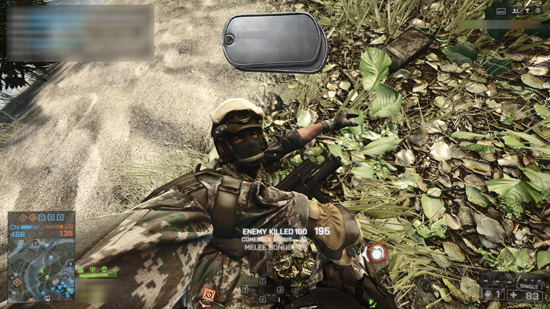Two years after the release of the highly anticipated Battlefield 3, DICE and Electronic Arts have delivered yet another Battlefield title, affectionately known has Battlefield 4. Yet, after months of top-dollar publicity and hype the latest in the series hardly lives up to the massive amounts of money, words, and videos spent touting the game as the best ever.
Though we have already ran through the campaign, in Battlefield 4, we have gotten over a dozen hours in multiplayer gameplay logged; it’s time for the full review.

Don’t be alarmed by what you've read so far, as a complete package the Battlefield 4 experience carries the torch of the series favorite Battlefield 2; but amid yet another catastrophe of technical issues plaguing the multiplayer experience at launch and old technologies or techniques in 3D graphics rendering being heralded as new breakthroughs in video games it is safe to consider the newest title as Battlefield 3.5.
Levolution
Ever since EA' first reveal the gaming community of Battlefield 4 back in March, the most singular aspect of the new title spoken about by the developers DICE has been what they have coined as, “Levolution.” However, the term should be referred to in the lower-case. As a technique in 3D graphical rendering every aspect of the levolution has been done before dating back as far as 2001 with the release of Red Faction. However, what DICE served up is more than a destructible environment, rather it is an interactive environment. In the multiplayer experience levolution’s greatest impact is at it’s microcosmic level; though the grandiose environment altering events are visually spectacular their impact on gameplay becomes trivial quickly as they occur the same way; whether the skyscraper in Siege of Sanghai, the resort in Hainan, or the Lancang Dam collapsing these events only marginal affect the flow of a battle.
The one massive event which does stand out and significantly augments gameplay for a particular map is flooding the streets in Flood Zone. Though the map initially has ankle deep water latitudinally and longitudinally, flooding the streets forces infantry to take refuge in the buildings at the middle of the map to it’s northern most objective (a multi-level parking garage) which makes for fantastic roof-to-roof gunplay as many of the upper level areas have concrete cover surrounding their outer walls. The more effective aspects of the levolution are within the smaller scaled interactive elements; elevators, switches that raise hydraulic barricades deterring the access of wheeled vehicles, or blowing up power generators cutting off electricity to a building thus killing the lights within it.
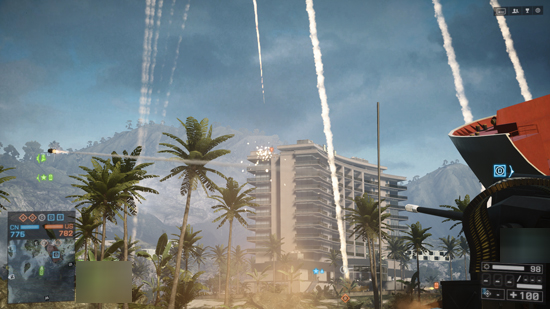
As a technological breakthrough Frostbite Engine 3 has not given gaming a new technique for a more destructive and interactive environment, it has not even brought this decade old reality into the Battlefield series. All of what you've seen in videos from DICE or in gameplay videos was possible through Frostbite 2 and therefore Battlefield 3; in fact it actually was, though not implemented to the degree it has been in the latest release. Remember the first mission in the campaign? When a sniper pins down the squad on a rooftop from an adjacent hotel? And an AT-4 is used to topple the massive structure burying the sniper within tons of concrete rubble? Or the building which topples over crushing an AH-6? A promotional video was produced to showcase both occurrences? So do I.
Instead, the levolution is a technique that is more form than function, a visual spectacle more than a dynamic environment-shifting mechanic that has been improved upon through Frostbite 3. Spec Ops: The Line achieved success with this concept using Unreal Engine 3 (as did Army of Two) but in similar fashion to Battlefield 4 was most present in single player. Though the levolution does add another layer to the multiplayer experience, it is a layer that at this time is a single step forward across a threshold rather than a step up.
Gameplay
For Battlefield 3 players that did not partake in the beta period which began a month ago, and have yet to purchase Battlefield 4, you are not missing out on much. Mostly, you are missing out on a gameplay feature that the series has been without since Battlefield 2142; a Commander slot in multiplayer.
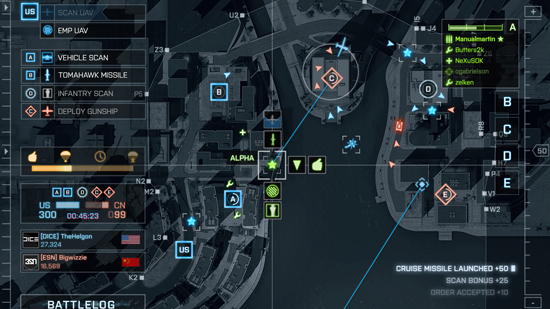
Instead of simply bringing back a past feature of multiplayer, DICE has rejuvenated not only the role of the Commander but player’s access to it. Though what you expect has returned, which in a shortened perspective is game changing, the Commander has at their disposal similar tools as before in Battlefield 2 with a few additions. They can issue attack orders at a specific objective, scan for enemy infantry and vehicles, drop supplies in the field, along with ordering cruise missile strikes. New in-game features for the Commander include UAVs and the AC-130 Gunship, which can provide a devastating impact if your opponents are poor pilots. Another new feature DICE has brought to the table is the integration of tablets, which is in all fairness the only true revolution to the series. For those that play the Battlefield series at the clan level, the integration of tablet devices and the Commander slot will make playing with your clan members that more accessible as you won’t need to be tethered to your desktop, but can influence matches along with your clan out in the world.
As for the naval aspect of the highly marketed and hyped levolution and Frostbite Engine 3, the dynamic and server-synchronized weather systems add little to the overall combined arms experience of multiplayer. An Attack Boat has been added to the vehicular arsenal which as an archetype is a floating Infantry Fighting Vehicle featuring the same weapon and defensive systems, a supplemental addition rather than a new layer of gameplay. Despite having a map designed specifically for this new addition to naval combat, Paracel Storm a oceanic map with a few atolls that serve as objectives, these Attack Boats in reality don’t greatly effect gameplay. As a weapons platform due to advancements utilized by Frostbite Engine 3 to generate dynamic waves, they are best utilized against each other; the problem being that they are easy prey targets to aircraft fixed-wing or rotary and furthermore are disadvantageous at engaging ground targets due to the sway of the seas and the fact that you can’t storm an objective on-land with a boat.
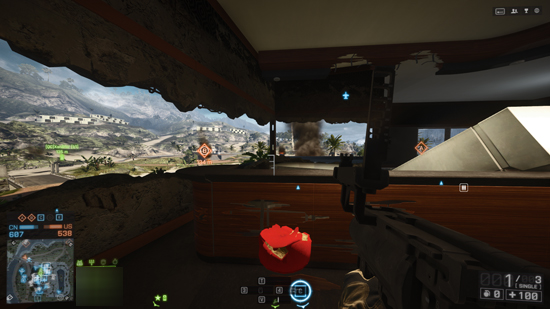
The weapon systems from land vehicles to aircraft and small arms offer little additions to gameplay as well. Many of the weapons, animations, and attachments from Battlefield 3 have been carried over, though to better fit the aesthetic of the combatants from the campaign new weapons and vehicles (mainly Chinese) have been added to the arsenal, while some from the previous title have been removed (rest in piece M60).
Partially destructible and permeable objects have also returned, another hold-over from Battlefield 3. Many objective buildings can have their concrete walls blown to rubble if not entirely toppled, such as Objective Foxtrot on Golmud Railway; however the environment is still not fully destructible. The aforementioned objective provides a keen example. A two-building industrial complex with two-storied interiors can have all of their concrete walls blown out, and once the support structure is sufficiently damaged the buildings can be brought down as well; akin to the Docks objective on Kharg Island from Battlefield 3. None-the-less, the concrete roof cannot be blown out which caused quite the annoyance while I rained down 105mm howitzer rounds from the AC-130 Gunship on a thoroughly suspecting foe. With a ballerina’s grace this guy danced among my splashing rounds (of which the splash damage hardly affected him) until I finally landed one on top of his helmet, all the while I continued to yell at the digital roof to collapse already; they were artillery rounds after all and minutes before I blew out a 10-foot chunk of wall on the ground level with a 40mm grenade. Other permeable objects include wooden boxes and concrete barriers or crenellations, even umbrellas shading lounge chairs; all of which fly apart like polygon voxel-fetti. Of course the equivalently sized spindles of heavy cabling are impervious to bullets, they even absorb splash damage quite well providing a wonderful platform to deploy a machine gun on.
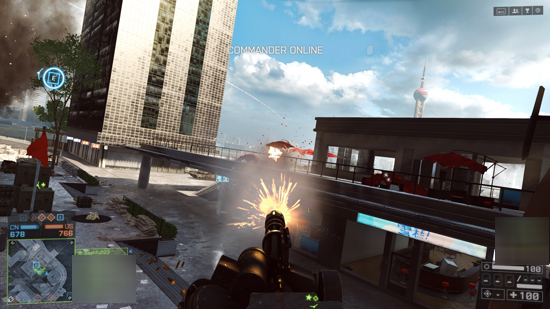
Due to many carry-over weapon systems, animations, and attachments and the return of the Commander slot, the differences in gameplay between 3 and 4 are marginal offering few new features. If you have played 2 and 3, you have played 4 as it combines the best of both titles. In that regard, Battlefield 4 is the true spiritual successor to the series high-water mark, Battlefield 2.
Graphics
Overall the graphical improvements to the Battlefield series between 3 and 4 are marginal. Though Frostbite 3 gave DICE a greater tool set for developing a graphical masterpiece, much of their focus fell into subtle or minimal aspects of the graphical experience; such as ambient and dynamic weather patterns or parallax animations on the iris of an eye.
However, improvements do present themselves which are anything but subtle. The lighting effects in Battlefield 4 are certainly a step up. The range of light gives a higher fidelity in color giving the textures all across the game more vibrant colors with more acute saturation that it’s predecessor. Having compared the two over the last few days, the quality of contrast in color seen in Battlefield 4 greatly surpassed the washed out colors from the third numerical title. The emphasis on lighting furthermore casts a greater disparity between illuminated and shadowed areas. The demarcation between a shadowed area and a well-lit area is greatly appreciated by an FPS player that has come to utilize shadows as both camouflage and an indicator to an on-coming foe giving an authentic quality to the game which DICE sought to provide through levolution.
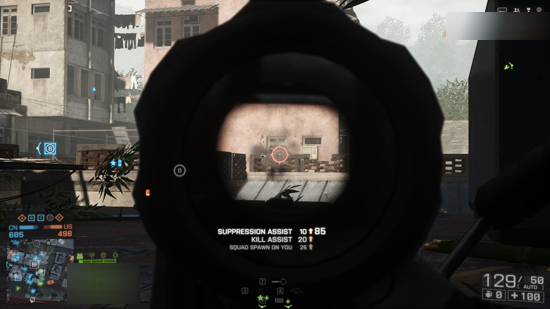
The lighting isn't perfect however. There is one lapse which DICE seems to have dropped the ball on. Though the waves as a structure are some of the best thus far in video game history, aspects of lighting and sky-to-water reflections create a stretched and awkward dissonance between the high-resolution clouds and low-resolution reflections that gives the surf a desolate soupy appearance, as if the surface is coated with a fine oil layer creating an obscuring sheen on the water texture. Refraction underneath the water level which can be experienced on Paracel Storm or Flood Zone, is also poor. While submerged on Flood Zone the environment below takes on a dark and violet appearance whether in a shadowed street or under direct sunlight.
The high intensity of sunlight can also be blindingly obnoxious. With the sun set low on the horizon one side of each battle for certain open-area maps such as Hainan Resort will be subject to a solar orgy of photons and not in a good way. The amount of glare and lensing furthermore casts a UV spectrum of color across the screen when facing in the direction of sunlight as if you are wearing polarized sunglasses or goggles. Due to the hue of the vehicle reticles, shooting at targets with the sun in the background becomes exceedingly difficult as the reticle washes into the background.
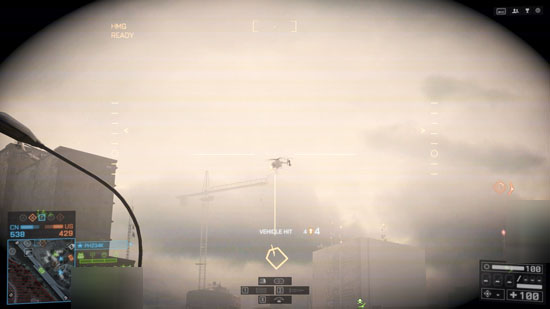
Technical Torment
It is no secret that many users have experienced nerve-racking if not cataclysmic technical issues since launch. EA even has a thread within their Answer HQ forum dedicated to PC users suffering from client crashes. That thread, titled “Battlefield 4 keeps crashing on PC,” is presently 97 pages long, at ten posts per page. Most users experience a crash to desktop mid-match after a few minutes to few hours of gameplay while others have experienced far worse; including computer restarts and blue screens. The latter of which can burn out hardware; I lost a Geforce 3 Ti500 to a blue screen which pains when I think about it to this day as it was a great card even though the PCB was pink. Another more comical bug I've noticed is that while accelerating land vehicles on Golmud Railway ambient audio will cut out. In tracked vehicles you will only hear the whine of the turret motors as you traverse back-and-forth while in wheeled vehicles like the jeep the game becomes eerily silent.
Similar issues plagued the launch of Battlefield 3 as well, however most of those issues were server related, lots of lag and poor server response timing and handling which led to characters and vehicles warping, or rubber-banding, around the map along with video stutter, the strobe-light effect. A nightmare to many excited Battlefield fans eager to get in on the multiplayer action. These issues have also returned, however the client crashes are what I have found as most alarming, as I experienced them as well.
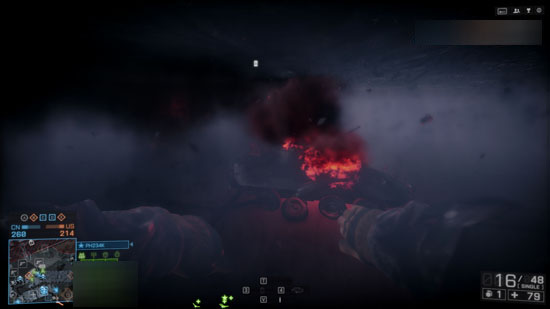
To note, I run an AMD FX-6100 at 4.5Ghz with 16Gb of RAM at 1600Mhz and a Geforce GTX660Ti overclocked with Nvidia’s 331.65 drivers on a solid-state Kingston drive. I meet each and every recommended spec for the settings I run (a mixture of high and ultra at 1920x1080). The 3Gb of recommended VRAM only affects those that run at a 4k resolution.
The culprit I expect is the same devil that has plagued Planetside 2. Poor engine optimization for modern hardware. A no brainer to I and other users, but a plausibility none-the-less for Battlefield 4. The Frostbite Engine is a complex beast which requires CPUs and GPUs to work in complete concert for smooth performance; given the enormous diversity in hardware options and software compliments. Despite altering every in game setting and turn off every single process through Task Manager that is not essential to running my operating system the game spikes on the CPU which commonly flushes the graphics card (meaning the data loaded into the VRAM has been discharged). When that occurs recovery is not an option as the client minimizes to desktop since the graphical data has been purged and can’t simply be switched back to through Task Manager. The only remedy is remotely crashing the BF4.exe and rejoining a server. As an extreme causality to a CPU spike and GPU flush is that your motherboard and or operating system red flags and restarts, or a kernel which manages communication between software and hardware errors resulting in a hardware failure that leads to a blue screen. If you aren't big on computer hardware and software, that is bad, very bad, Godzilla in Tokyo bad.
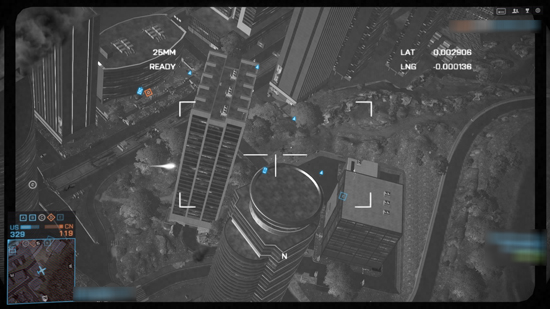
Though in time, we can bet on DICE correcting many of the technical issues experienced during the launch period of Battlefield 4, as they did with Battlefield 3; however, the game is not a finished and polished product at this time. The plethora of responses to the Answer HQ thread is example enough, though anecdotally I verify that these technical issues are real and have capsized the multiplayer experience. Which is a travesty as the multiplayer experience is just as fun and exciting as in 2 and 3; the frustrations are manifested in the form of poor engine to hardware optimization which hopefully will be remedied by frequent post-release patches, if not by the Mantle API update scheduled for December.
Now that Battlefield 4 is out and the gaming community has had time to play through the campaign and hit double digits in ranks on multiplayer, the most disappointing aspect of the game for the PC-verse is a loss of personality. What drove myself and others to this franchise a decade ago was phenomenal gameplay and also developer tools that allowed the capable few to modify the game giving each title re-playability well beyond it's shelf-life. People to this day still play Battlefield 2, it is true! Why or rather how you ask? Project Reality. The most recent of which, v1.0 was announced back in August. That is the personality which Battlefield built it's fanbase on; but as EA and DICE continue to compete with Activision's Call of Duty franchise, that personality will continually fade away title after title until it is gone.
